The Bottom Line
Pros
- + Solid 1080p performer
- + It outperforms the GeForce RTX 3060 and is priced lower
- + Competes with the GeForce RTX 4060 in several games
- + Sturdy build and great thermal performance
Cons
- - 1440p performance isn't great
- - Ray-tracing is a step or two behind the competition
- - FSR 3 works but is unimpressive at 1080p
Should you buy it?
AvoidConsiderShortlistBuyIntroduction
Launching earlier this year, AMD's Radeon RX 7600 represents the company's current mainstream GPU offering optimized for 1080p gaming. Even though 1080p gaming has been a thing for many years now, it's worth remembering that running a visually impressive game from 2023 at 1080p is very different from running a game from 2016 at 1080p. As the mainstream RDNA 3 GPU from Team Red, it's a direct competitor to NVIDIA's GeForce RTX 4060, with a lower MSRP of USD 269.
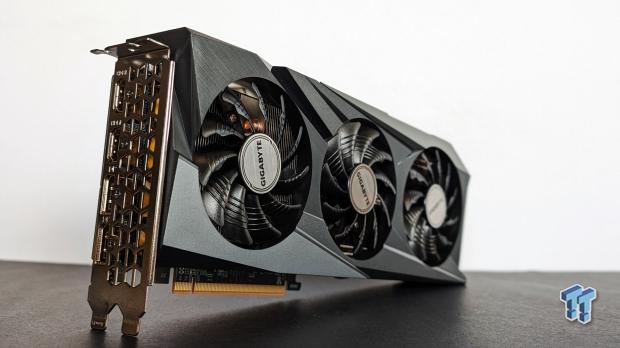
Since the Radeon RX 7600 debuted, AMD has now released the full product lineup for RDNA 3 with the mid-range Radeon RX 7700 XT and enthusiast-class Radeon RX 7800 XT. With this review of the GIGABYTE Radeon RX 7600 OC 8G, we'll look at the performance difference across the full RDNA 3 lineup and compare the performance to NVIDIA's mainstream GPU released around the same time.
Another new element that cropped up since our first stack of reviews of the Radeon RX 7600 is the long-awaited arrival of FSR 3 and AMD's answer to NVIDIA's Frame Generation called 'Fluid Motion Frames.' Unlike DLSS 3 and Frame Gen, AMD's approach is not exclusive to the Radeon RX 7000 Series - it works with all modern GPUs. This review takes a look at FSR 3 on the GIGABYTE Radeon RX 7600 OC 8G in a couple of games, and even though it's not on par with the visual fidelity of DLSS 3 (especially at 1080p), it's a cool addition to the RDNA 3 generation of graphics cards.
Let's dig in.

The RDNA 3 Generation
"The world's first chiplet gaming GPU" is how AMD described its new RDNA 3-based GPUs when it lifted the lid on the new Radeon RX 7000 Series. In layperson's terms, the GPU chip isn't just one big square or die anymore, with billions of transistors all arranged in a single layout. Like with its Ryzen CPU range, which embraced chiplet design to great effect (look at how Ryzen has grown in popularity over the years), bringing this design philosophy into the GPU space felt like the natural evolution for AMD's Radeon brand.
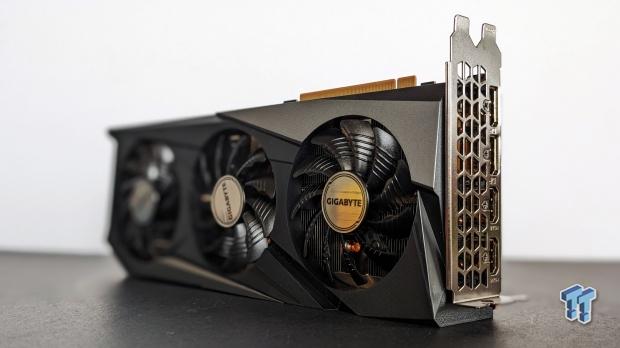
For RDNA 3, what was once a single Graphics Compute Die (GCD) has now split into a GCD plus a Memory Cache Die (MCD). The GCD still makes up most of the hardware grunt and uses the newer 5nm process technology - a step up from RDNA 2's 7nm process. Interestingly, the MCD uses 6nm process technology, which allows AMD to keep costs down as the complexity and cost of manufacturing high-end tech continue to rise.
And to mitigate any performance impact that could arise from going the chiplet route, AMD has also managed to include the "fastest chiplet interconnect in the world," with speeds of 5.3 TB/s. That said, the Radeon RX 7600 and entry-level models using the 'Navi 33' GPU follow a more traditional single-chip setup using 6nm process technology to help keep costs down. But with the same RDNA 3 architecture as the Radeon RX 7700 XT, 7800 XT, and 7900 XT.
AMD's RDNA 3 architecture features second-generation AMD Infinity Cache, another CPU-like feature designed to boost performance in 1440p and 4K gaming - a "bandwidth amplifier" that sits alongside the GDDR6 memory interface. It helps alleviate the need for more expensive and power-hungry memory buses and is one of those forward-thinking designs we love seeing.
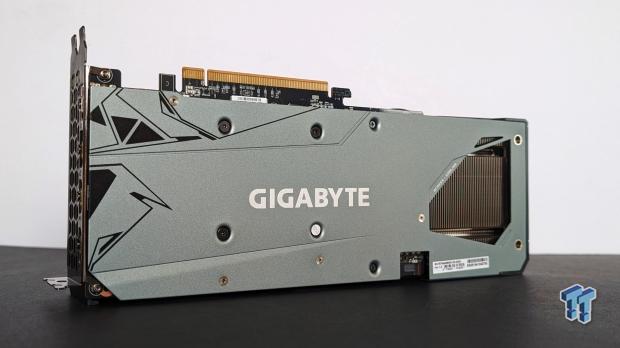
RDNA 3 also represents a significant leap forward for AMD regarding ray-tracing and AI accelerators. RDNA 3 GPUs feature the second generation of dedicated RT hardware and new hardware-based AI acceleration. Real-time ray tracing is hardware intensive; this is one area many were looking for AMD to improve compared to RDNA 2. Which, admittedly, was the company's first attempt at hardware-based ray tracing.
RDNA 3 GPUs are the first graphics cards supporting the new DisplayPort 2.1 spec. The latest DisplayPort interface supports up to 4K 480Hz and even 8K 165Hz, which makes it more of a future-proofing measure than something applicable today. But the real benefit comes with 12-bit HDR support and full Rec2020 coverage for improved color accuracy and detail.
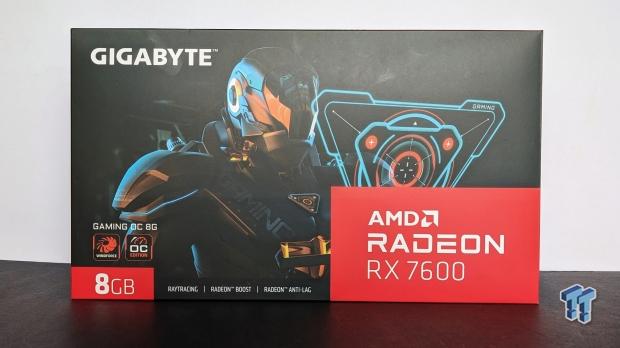
RDNA 3 also introduces hardware-based AV1 encoding to step up its video game for content creators, which means better quality video using the same bitrate. Very cool. For gamers, the introduction of AMD FSR 2 and FSR 3 rendering is fully supported and helps improve performance in intensive games.
FSR 2 support might not be as widespread as NVIDIA DLSS, but its addition to games like Cyberpunk 2077 and Star Wars Jedi: Survivor is a great sign. Plus, as the tech is supported on Xbox Series X|S and PlayStation 5 (with both consoles using AMD graphics hardware), in-game FSR support should grow as time passes. In late 2023, AMD introduced its DLSS 3-like FSR 3 frame generation technology, which uses generated frames and low-latency tech to boost perceived performance. With FSR 3 in its infancy, it's a technology set to mature in the coming months and years.
Ultimately, RDNA 3 is an impressive leap forward for AMD, bringing massive changes to the underlying hardware while delivering a sizable performance leap over the previous RDNA 2 generation.
Specs and Test System
Specifications
Here, we can see how the specs and hardware stack up for the AMD Radeon RX 7600 compared to the previous generation's AMD Radeon RX 6600.
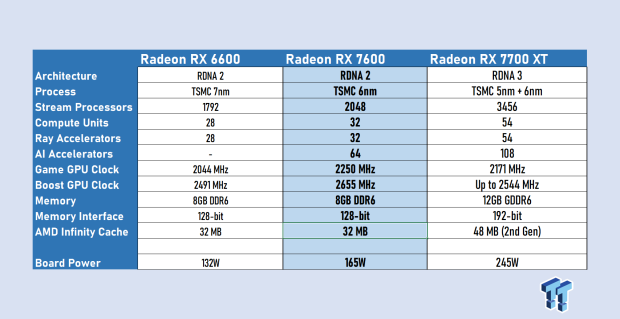
Interestingly, AMD chose to release a Radeon RX 7600 versus a Radeon RX 7600 XT, as the RDNA 2-era Radeon RX 6600 XT is the card we most associate with mainstream PC gaming from that generation. Per the image above, we've included specs for the baseline Radeon RX 6600 and this generation's more powerful RDNA 3 offering, the Radeon RX 7700 XT.
Compared to the previous generation Radeon RX 6600, you've got a modest increase to the Stream Processor and Compute Unit count in the region of 14.3%. This slight bump also applies to the GPU clock speeds. However, the GIGABYTE Radeon RX 7600 OC 8G reviewed here pushes the reference Boost Clock speed even higher with an out-of-the-box 2755 MHz. Of course, there are several architectural differences between RDNA 2 and RDNA 3, from the latest RT hardware from AMD and next-gen Infinity Cache.
As the mainstream RDNA 3 GPU, the GPU design follows a traditional single-chip approach with a 6nm process compared to the 5 and 6nm mix in the Radeon RX 7700 XT and above. One area where AMD's RDNA 3 lineup seems to have fallen short is with power efficiency, with the baseline power rating of the Radeon RX 7600 being 165W (or 180W or so in OC models like this) - which is notably higher than the Radeon RX 6600's power-rating of 132W.
Elsewhere, like NVIDIA has chosen to do with the GeForce RTX 4060, the AMD Radeon RX 7600 retains its predecessor's 8GB of GDDR6 on a 128-bit interface. Memory capacity and bandwidth have been a hot topic within the PC gaming community in 2023, and even though AMD Infinity Cache helps boost the memory bandwidth to an effective 476.9 GB/s, the 8GB ceiling does limit the Radeon RX 7600 to 1080p gaming for the most part.
Finally, with the arrival of the Radeon RX 7700 XT, we see a pretty sizable gap between these two cards beyond using a multi-chip setup.
Specs-wise, the newer (and granted, more expensive) Radeon RX 7700 XT features a whopping 68.8% higher Stream Processor, Compute Unit, and Ray Accelerator count. Not only this, but you've got a 50% increase in VRAM capacity. It shows us that AMD has plenty of room to slot in a Radeon RX 7600 XT or RX 7700 between the two.
- GPU: AMD Radeon RX 7600
- Model: GIGABYTE Radeon RX 7600 OC 8G
- Interface: PCI Express 4.0
- Stream Processors: 2048
- Clock Speeds: Up to 2755 MHz (Boost Clock)/Up to 2355 MHz (Game Clock)
- Memory: 8GB GDDR6
- Memory Speed: 18 Gbps
- Memory Interface: 128-bit
- Display Connections: 2 x HDMI 2.1a, 2 x DisplayPort 1.4a
- Power Connectors: 1 x 8-pin
- Total Board Power: 185W
- What's in the Box: GIGABYTE Radeon RX 7600 OC 8G, Quick Guide
Kosta's Test System
- Motherboard: MSI MPG X670E Carbon Wi-Fi
- CPU: AMD Ryzen 9 7900X
- Cooler: Corsair iCUE H100i RGB PRO XT Liquid CPU Cooler
- RAM: 64GB (2x32GB) Corsair DOMINATOR PLATINUM RGB DDR5 DRAM 5200MHz
- SSD: Sabrent Rocket 4 Plus-G M.2 PCIe Gen 4 SSD 4TB, Sabrent Rocket 4 Plus M.2 PCIe Gen 4 SSD 8TB
- Power Supply: Thermaltake Toughpower GF1 850W
- Case: Thermaltake Core P3 Tempered Glass Snow
- OS: Microsoft Windows 11 Pro 64-bit
Physical Design and Cooling
With dimensions of 282 x 115 x 50 mm, even the GIGABYTE Radeon RX 7600 OC 8G is still quite compact with a 2.5-slot thickness and low profile that sits lower or closer to the motherboard than most two-fan Radeon RX 7600 options out there. As a mainstream GPU in 2023, being smaller is something we always like to see as it makes the installation process easier and opens the door to more case options and configurations. Of course, larger and more robust cooling has the added benefit of keeping GPU temps in check.
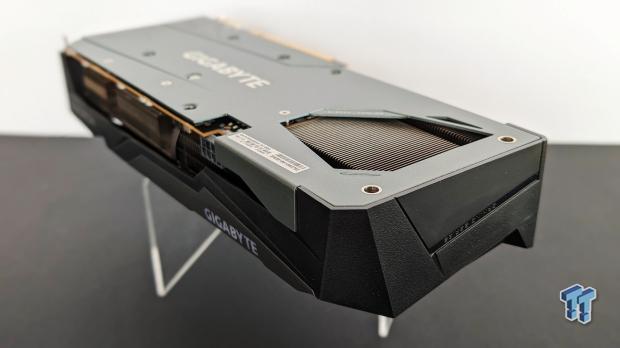
The GIGABYTE Radeon RX 7600 OC 8G ships with an out-of-the-box overclock, and even though it's a mainstream GPU - the build quality here is impressive. In addition to a protective metal backplate, you've also got GUGABYTE's WINDFORCE cooling system with alternate spinning fans designed to increase airflow pressure. Like many modern GPUs, the fans will stop when the temperature drops below a certain threshold for silent performance when you're not gaming.
GIGABYTE's fan tech has been impressive for a while now, and in terms of the overall noise output, the GIGABYTE Radeon RX 7600 OC 8G has been one of the quietest Radeon RX 7600 models we've put to the test. Temperatures remain low even when under load, which is always great to see.
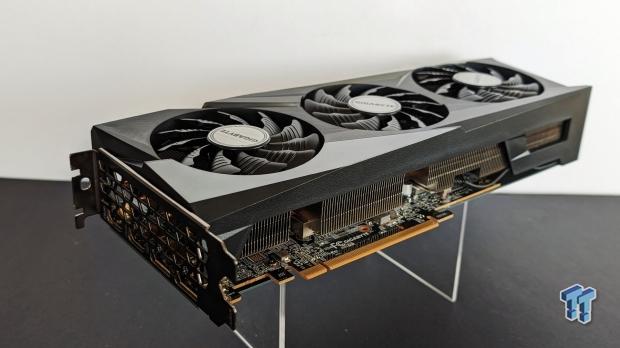
Aesthetically, the GIGABYTE Radeon RX 7600 OC 8G features an angular silver and black design with an impressive fully enclosed meets open design (you can see the fins). There's RGB here, too, with the GIGABYTE logo lighting up. This can be configured via the GIGABYTE CONTROL CENTER (GCC) app, which also offers fan controls and OC profiles to tweak.
Benchmarks - 15 Game Averages
The Games and Tests
In 2023, PC gaming is a complicated and varied space, from indie games to major blockbuster releases and titles that push hardware and technology to their limit with the adoption of effects like real-time ray-tracing.
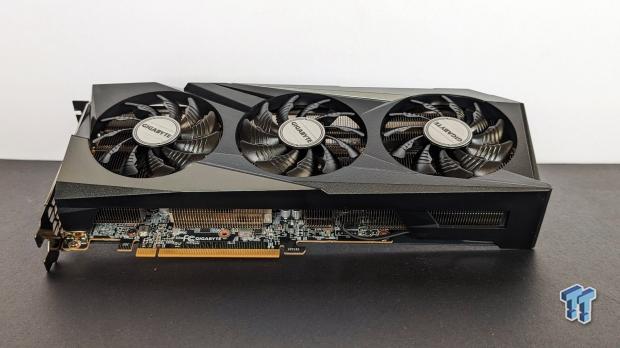
This is all a way of saying that the 15 in-game benchmarks we've chosen (and run at 1080p and 1440p) represent a wide range of styles, not only in terms of genres, like first-person shooters and racing games, but also in the API technology (DirectX 11, 12) and cutting-edge features like ray tracing and upscaling technology.
Results include DLSS and FSR 2, where possible, as both technologies are the sorts of things, especially in 1440p and 4K, which you'd turn on. Six of the 15 game benchmarks also feature ray tracing. Also, each title is set to ultra-equivalent quality settings to push GPU hardware and minimize CPU bottlenecks at higher resolutions.
Also, it's just fun to max out a game's visual settings and see the results. Here's the breakdown of games, graphics settings, and what's being tested.
- Assassin's Creed Valhalla: Ultra High-quality settings, with the in-game benchmark tool used.
- Borderlands 3: Ultra quality settings, with the in-game benchmark tool used.
- Call of Duty: Modern Warfare II: Ultra quality setting, in-game multiplayer benchmark tool used.
- Cyberpunk 2077: Ultra quality setting, in-game benchmark tool used. AMD FSR and NVIDIA DLSS results are included.
- Cyberpunk 2077 (RT): Ray tracing Ultra quality setting, in-game benchmark tool used. AMD FSR and NVIDIA DLSS results are included.
- DOOM Eternal (RT): Ultra Nightmare quality setting with ray-tracing enabled, the opening of Mars Core campaign level used to benchmark.
- F1 22 (RT): Ultra High-quality setting with ray tracing, one lap of the Bahrain track benchmarked. AMD FSR and NVIDIA DLSS results are included.
- Forza Horizon 5 (RT): Extreme quality setting with ray tracing enabled, in-game benchmark tool used. AMD FSR and NVIDIA DLSS results are included.
- Hitman (RT): Ultra-quality settings with ray-tracing, Dubai scene benchmarked. AMD FSR and NVIDIA DLSS results are included.
- Horizon Zero Dawn: Ultimate quality setting, in-game benchmark used.
- Marvel's Guardians of the Galaxy (RT): Ultra quality setting with ray tracing enabled, the in-game benchmark tool used.
- Rainbow Six Extraction: Ultra quality settings and in-game benchmark tool used.
- Red Dead Redemption 2: Maximum quality settings, with in-game benchmark tool used. AMD FSR and NVIDIA DLSS results are included.
- The Division 2: Ultra quality settings with in-game benchmark tool used.
- Total War: Warhammer III: Ultra-quality settings with the in-game Battle Benchmark tool used.
15 Game Average FPS - 1080p Results
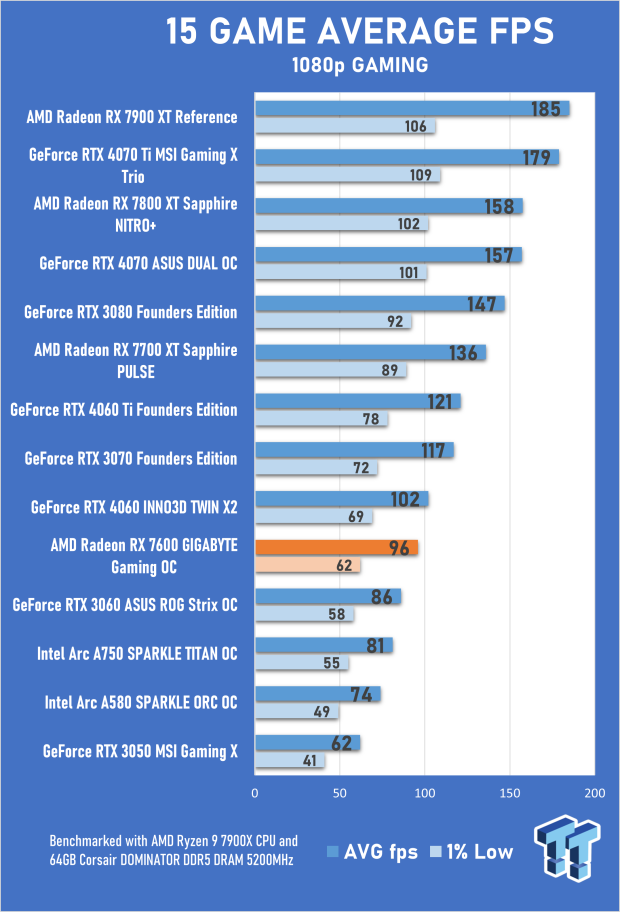
Unfortunately, without a Radeon RX 6600 on hand, we won't be offering a gen-on-gen comparison - instead, we'll focus on how it performs compared to the world's most popular GPU (according to the latest Steam Hardware Survey results) - the GeForce RTX 3060. As well as compare it to the current mainstream option for NVIDIA's latest generation, the GeForce RTX 4070. Plus, throw in a few notes about the performance gap between the Radeon RX 7600 and the beefier Radeon RX 7700 XT.
Across our 15-game benchmark suite, which includes several games with ray-tracing effects enabled, the GIGABYTE Radeon RX 7600 OC 8G delivers solid performance with an average of 96 FPS and 1% lows sitting above 60 FPS. This puts the average performance at around 11.6% higher than the GeForce RTX 3060 and about 5.9% lower than the GeForce RTX 4060.
However, the individual results vary quite a bit from game to game. On the high-end Call of Duty: Modern Warfare II's result of 125 FPS is a sizable 28.9% faster than the GeForce RTX 4060 and 4% faster than the GeForce RTX 4060 Ti. With RT effects enabled in games like Cyberpunk 2077 and DOOM Eternal, the GIGABYTE Radeon RX 7600 OC 8G falls behind the GeForce RTX 3060 by a considerable margin.
Ray-tracing is not the Radeon RX 7600's strong suit; Intel's more affordable Arc range trumps the RT performance you'll get. However, for 1080p gaming, the GIGABYTE Radeon RX 7600 OC 8G is worth considering - even if it's 29.4% slower than the Radeon RX 7700 XT.
14 Game Average FPS - 1440p Results
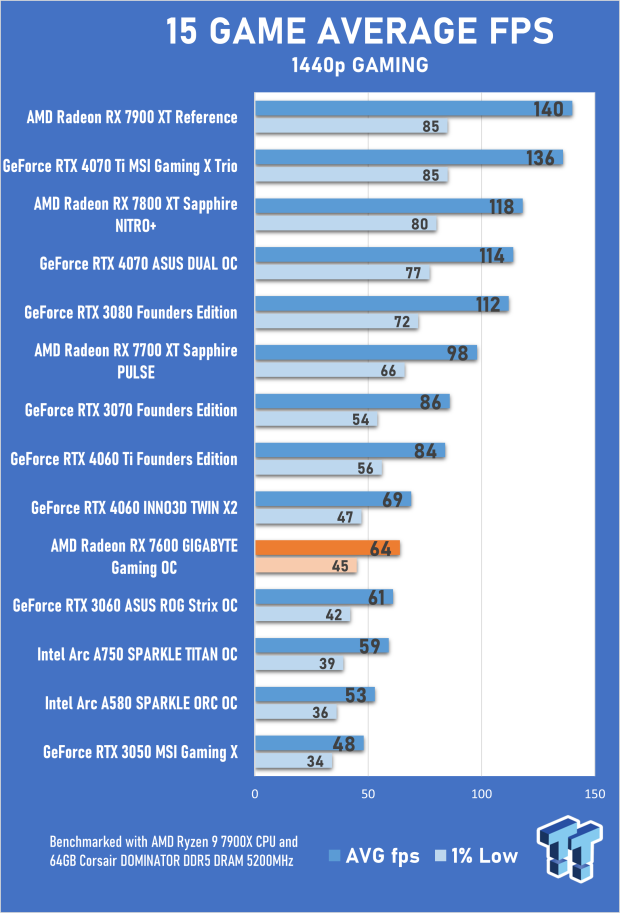
1440p is the fastest-growing resolution among PC gamers, and we're slowly inching towards a future where displays with this native resolution will become the norm for mainstream GPUs like this. The GIGABYTE Radeon RX 7600 OC 8G isn't quite there, but with a 64 FPS average across our 15-game benchmark suite, depending on the game and workload, it's 1440p capable.
RT performance at this resolution is, as expected, not good at all - but with Borderlands 3 hitting 80 FPS, Call of Duty: Modern Warfare II 82 FPS, and Red Dead Redemption II 62 FPS, you can game in 1440p with the Radeon RX 7600. At this resolution, the image quality of FSR 2 upscaling using the Quality mode is passable and worth enabling to boost performance where available.
That said, the 1440p performance here is disappointing, with the GIGABYTE Radeon RX 7600 OC 8G's performance lead over the GeForce RTX 3060 dropping to 4.9% while being about 7.2% slower than the GeForce RTX 4060. Again, the results vary from game to game, so there's a give and take.
Benchmarks - 3DMark FireStrike
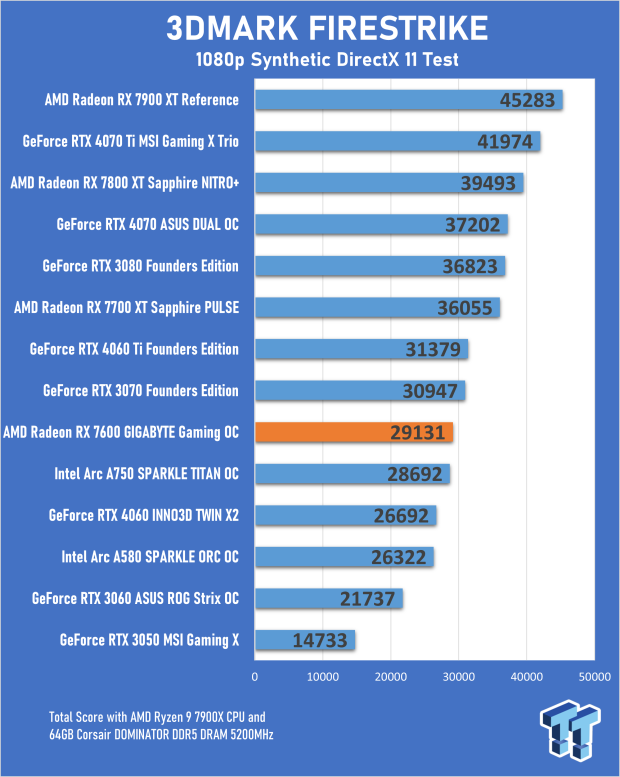
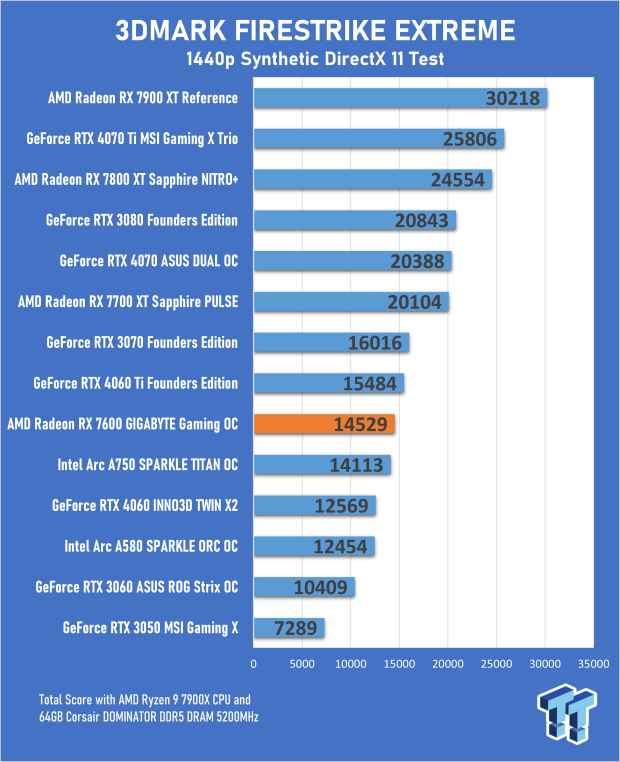
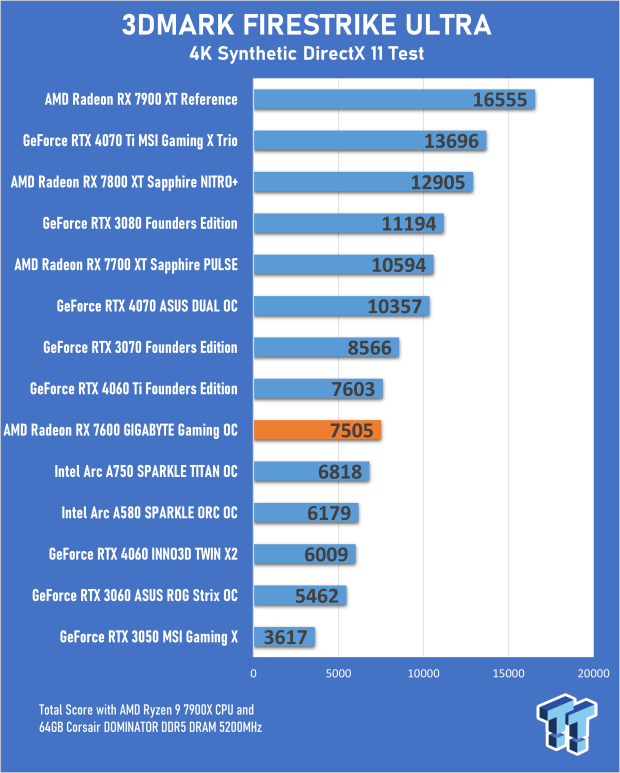
3DMark FireStrike is a DirectX 11 test that has been around for many years and covers quite a large portion of games released over the past decade - at least in terms of the API and graphics technologies used. The three tests cover the resolutions - 1080p, 1440p, and 4K. The results we see for the GIGABYTE Radeon RX 7600 OC 8G paint a different picture to the average in-game benchmark tests - with the mainstream RDNA 3 GPU sitting above the GeForce RTX 4060.
Also, the 3DMark FireStrike score for the baseline 1080p synthetic benchmark shows the GIGABYTE Radeon RX 7600 OC 8G, delivering a score 34% higher than the GeForce RTX 3060. It's the sort of result where, if that's all you saw, you'd think the Radeon RX 7600 would present a sizable upgrade over the GeForce RTX 3060 when the actual in-game results show a different story. For the 3DMark FireStrike benchmarks, this discrepancy is something we've seen across the entire RDNA 3 lineup - though it might be the most prominent here.
Benchmarks - 3DMark TimeSpy and Port Royal
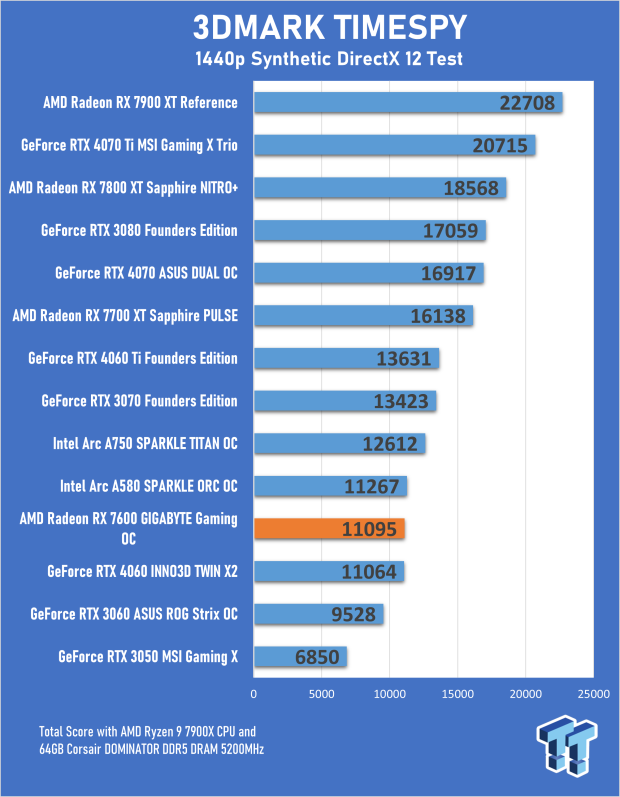
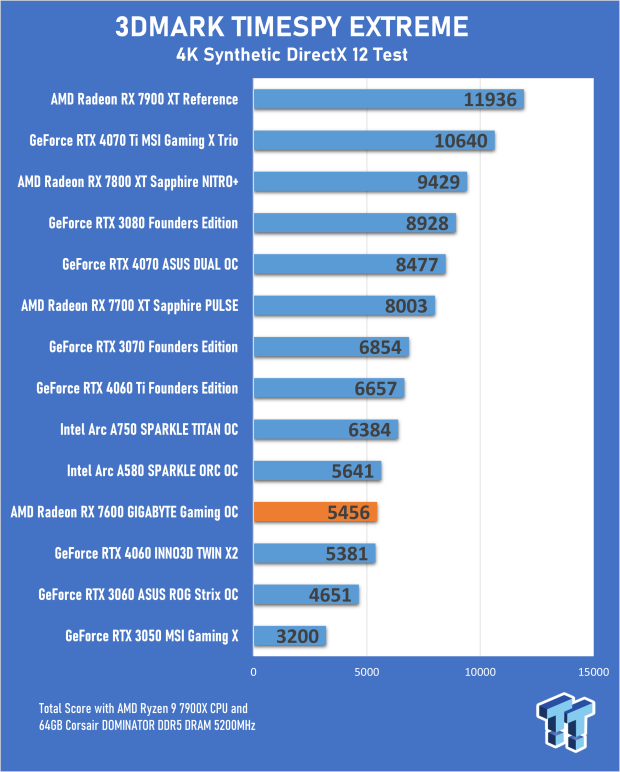
3DMark TimeSpy is DirectX 12-based, so it's a more relevant synthetic benchmark for modern games. Here, the results closely match the individual in-game benchmark results and averages we found across our 15-game benchmark suite. The baseline 3DMark TimeSpy total score of 11095 for the GIGABYTE Radeon RX 7600 OC 8G is on par with the GeForce RTX 4060 while being 16.4% higher than the GeForce RTX 3060.
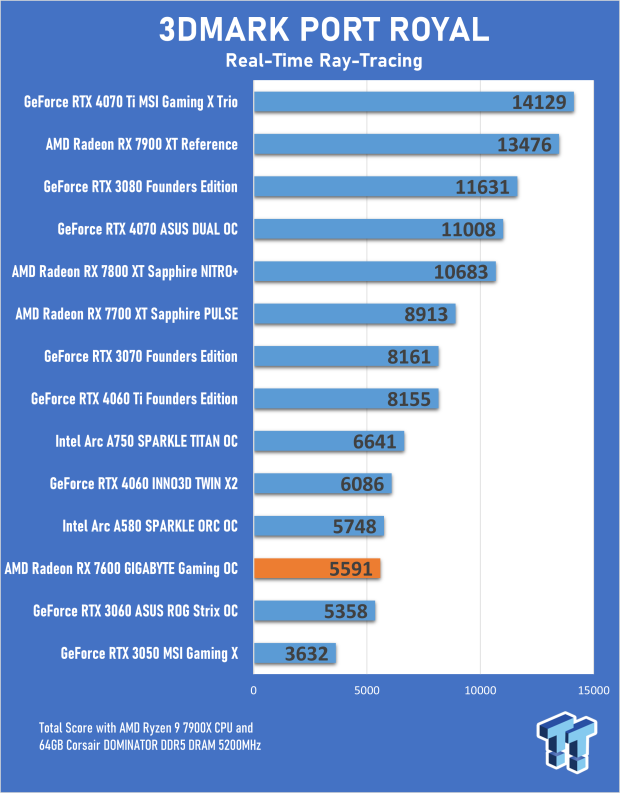
3DMark Port Royal is a synthetic ray-tracing benchmark - an area in which we've already noted that the Radeon RX 7600 is a step behind the competition. With a score of 5591, the GIGABYTE Radeon RX 7600 OC 8G sits in between the GeForce RTX 3060 and GeForce RTX 4060. The results of games with light RT workloads, like F1 22 and Forza Horizon 5, match the score we see here.
However, fire up a game with lots of RT effects like Cyberpunk 2077 and Hitman, and the Radeon RX 7600 cracks under the pressure. Ray-tracing at the mainstream level is something you'd always consider pairing with upscaling tech like FSR 2 and DLSS - but for the GIGABYTE Radeon RX 7600 OC 8G, you'd probably need to go one step further and set RT levels to low or medium.
Benchmarks - 1080p Gaming
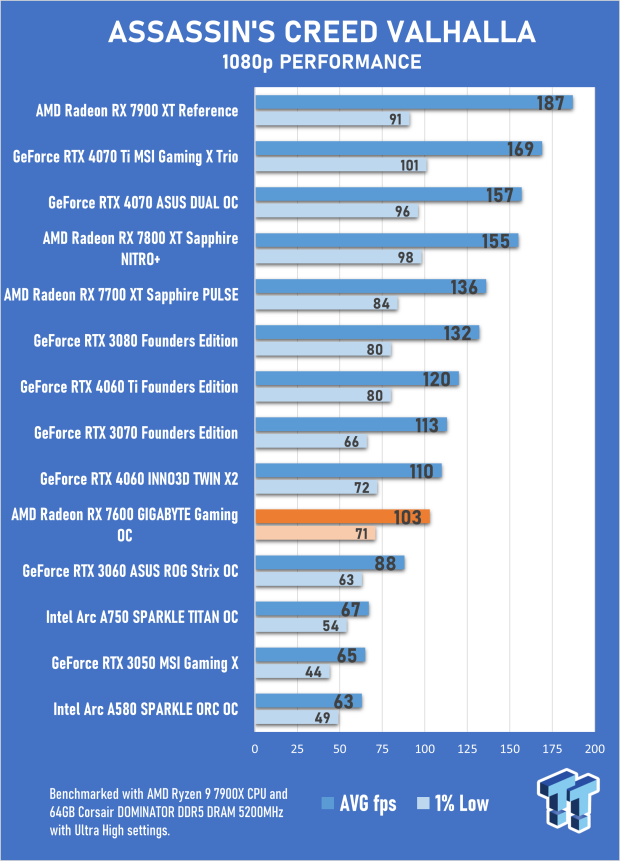
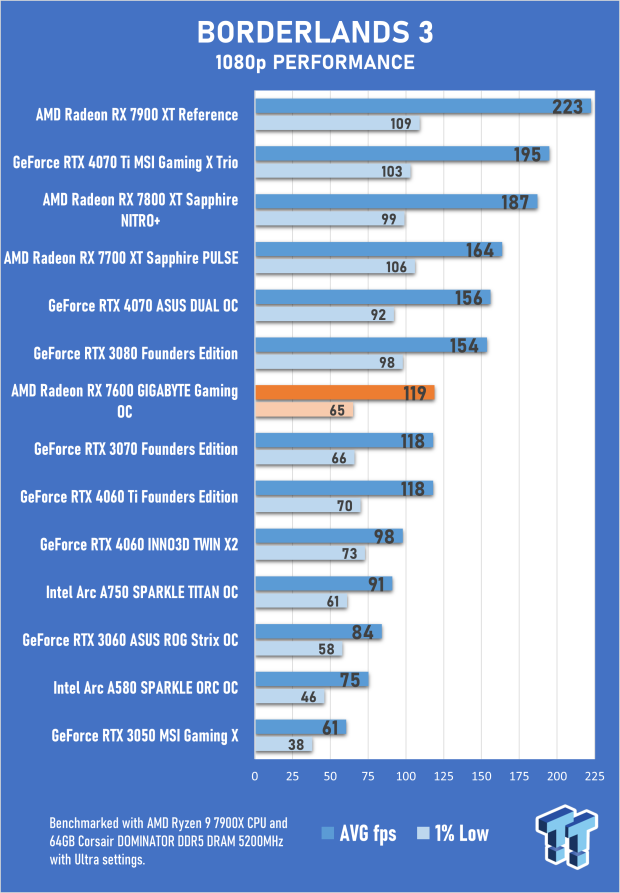
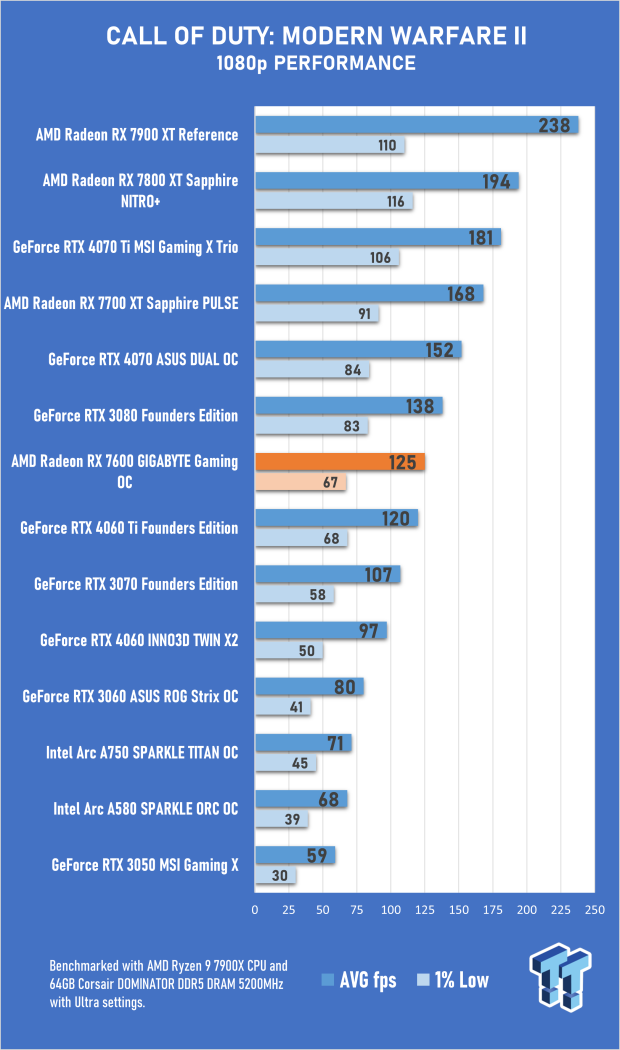
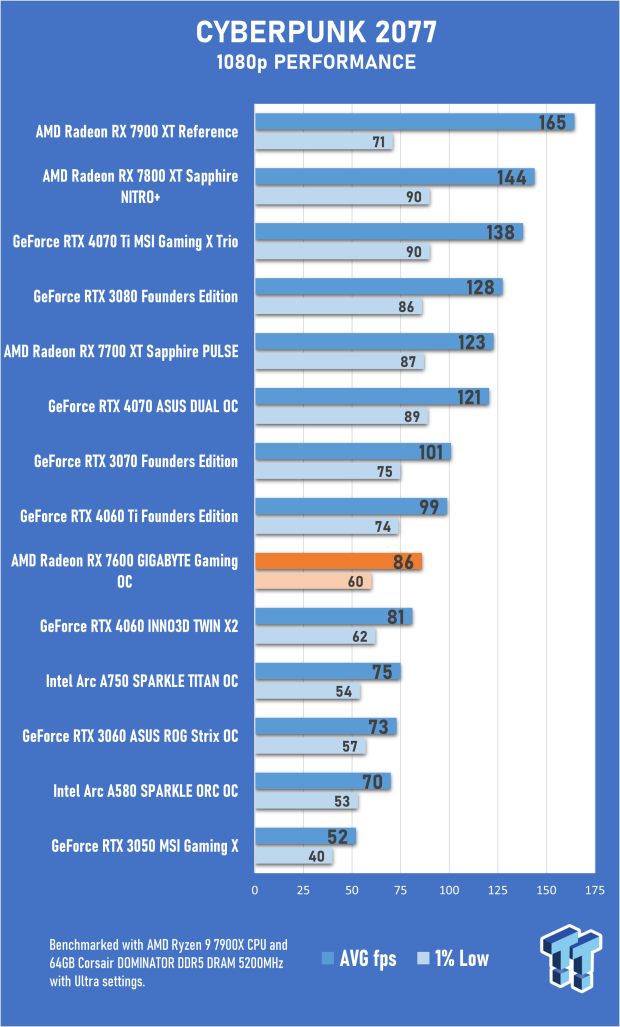
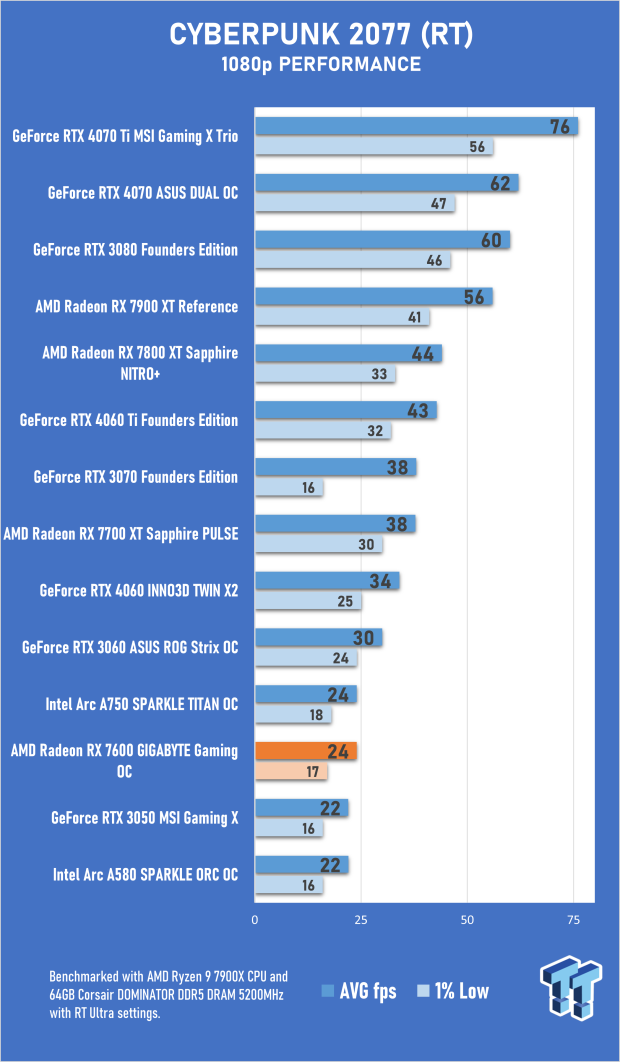
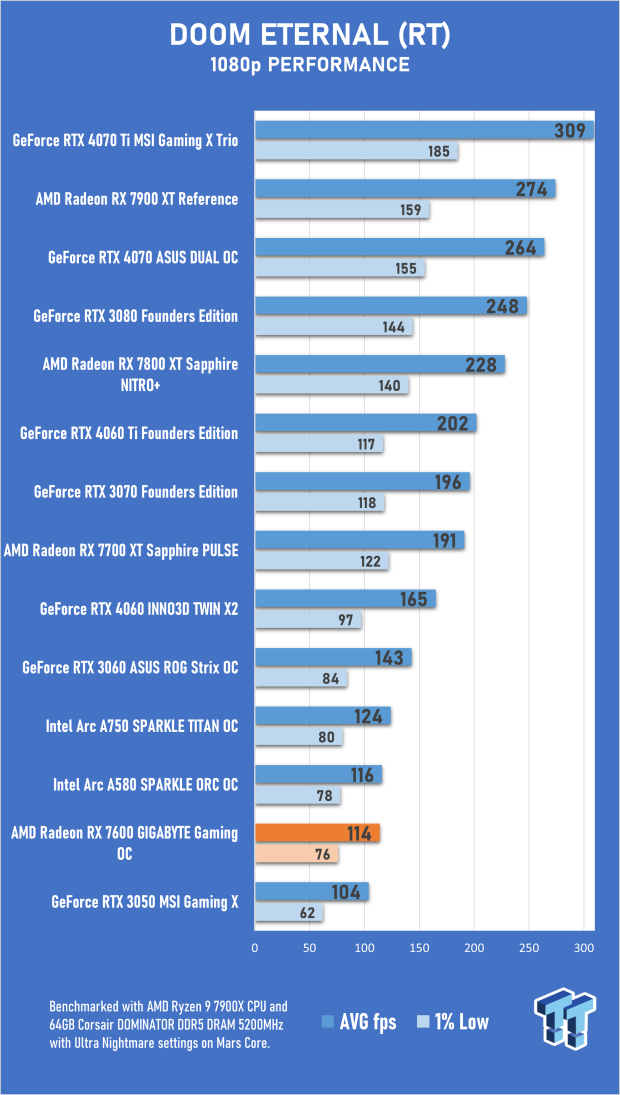
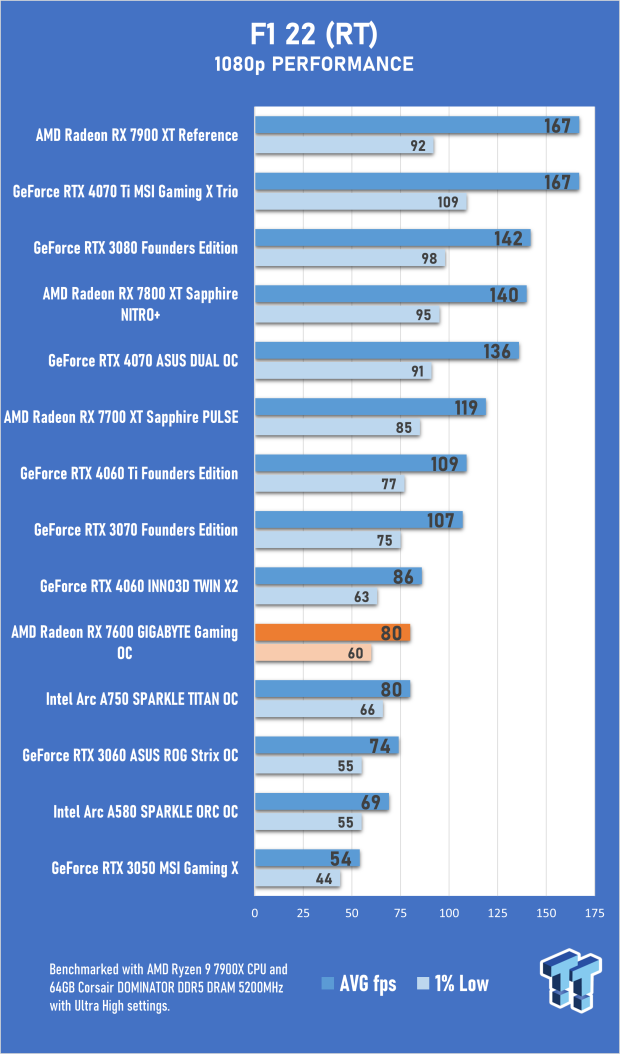
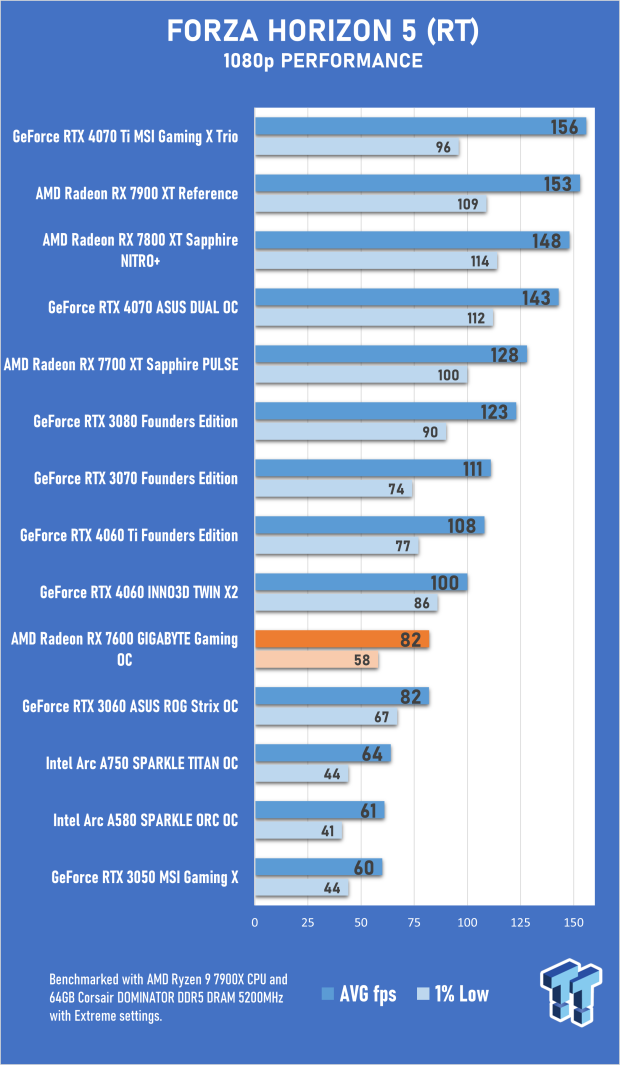
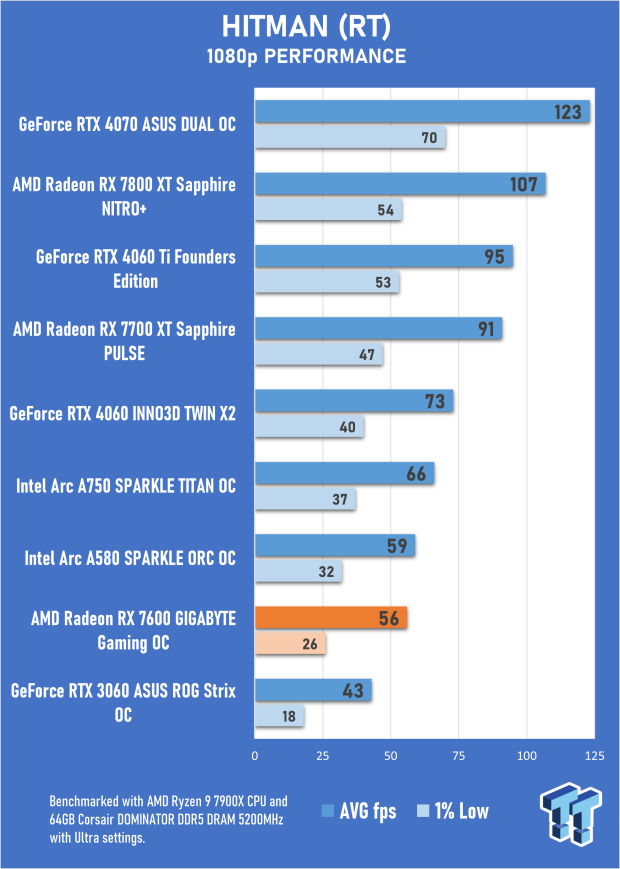
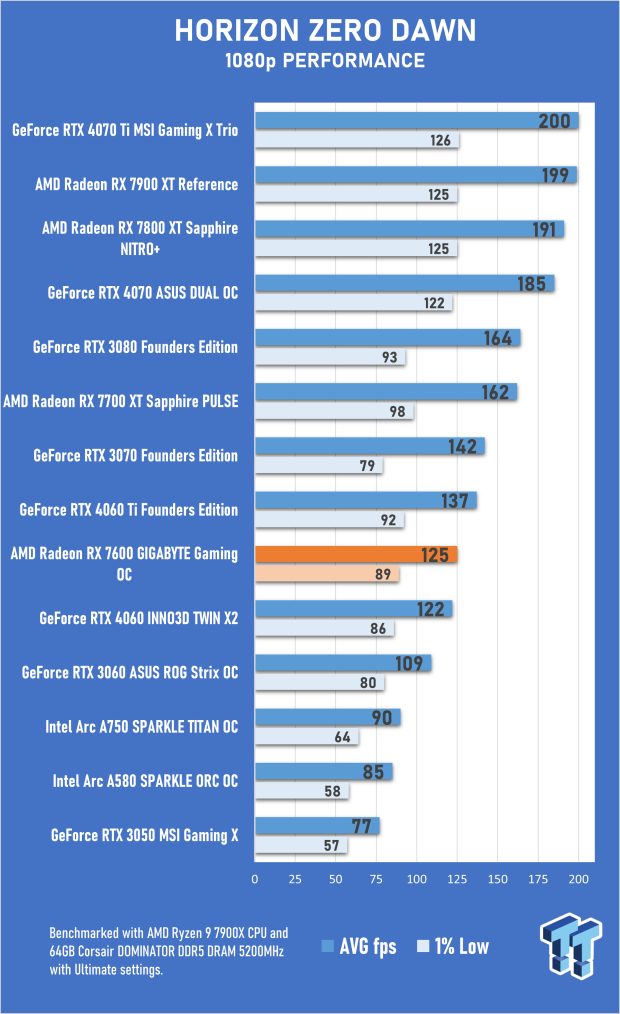
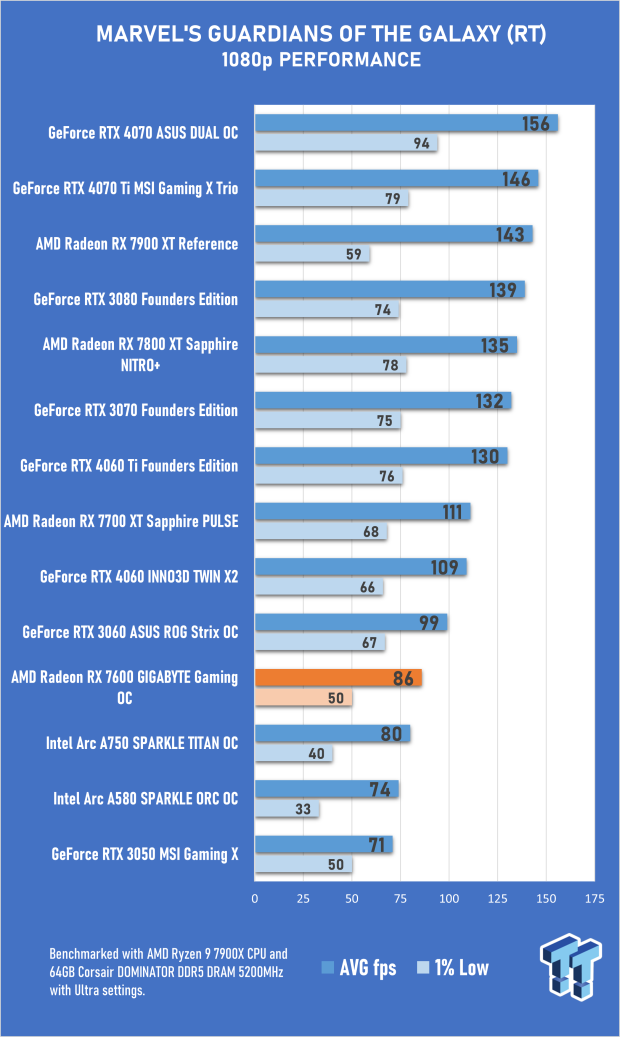
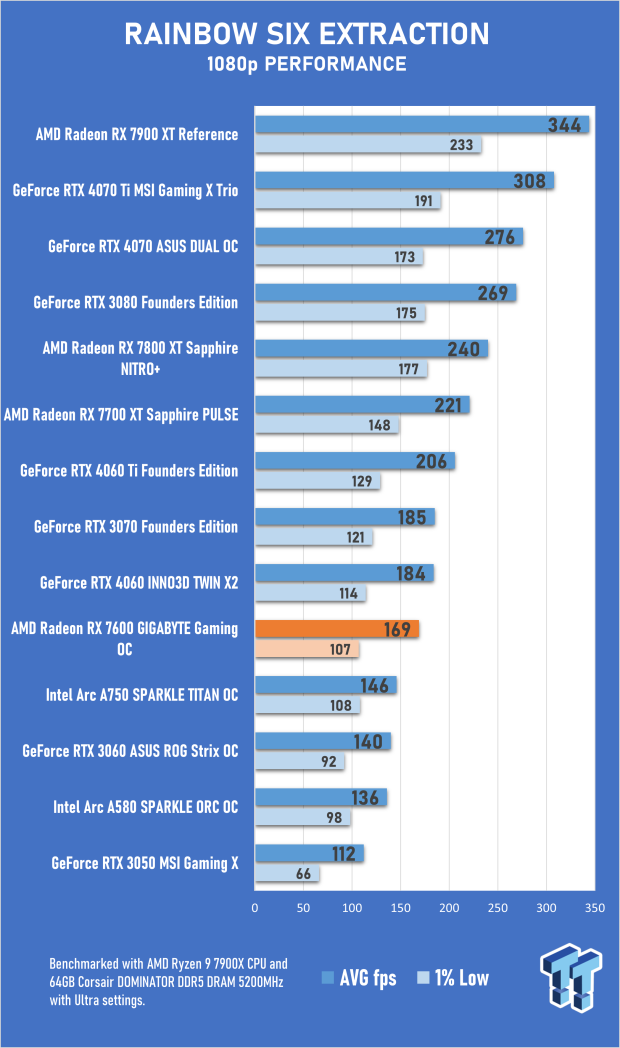
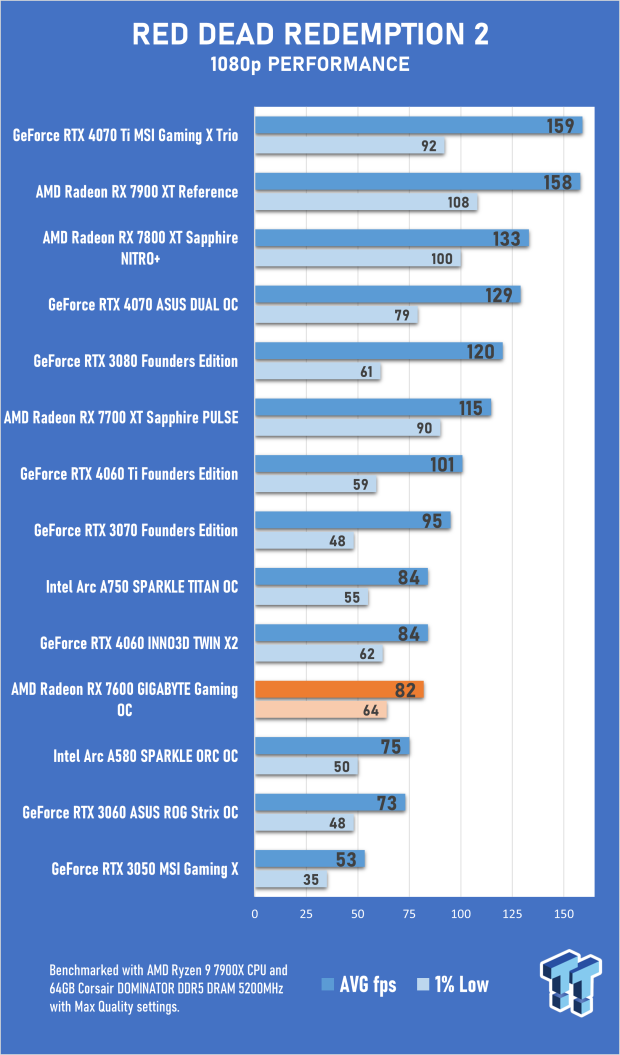
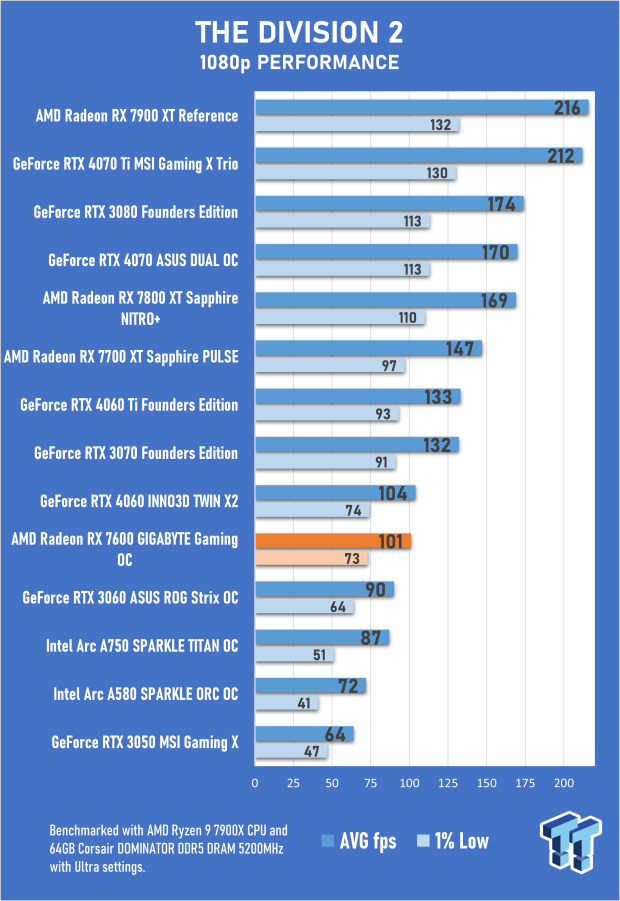
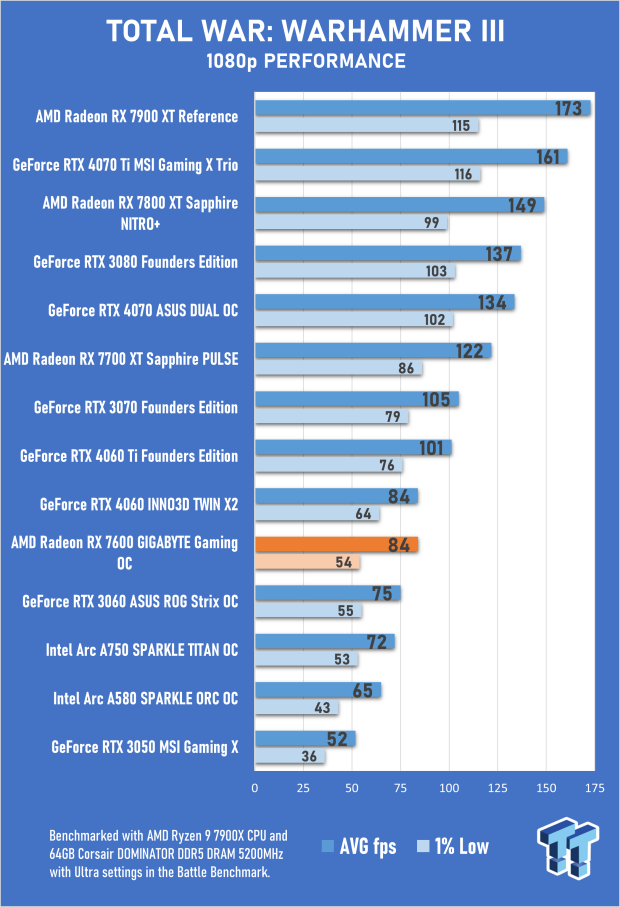
Benchmarks - 1440p Gaming
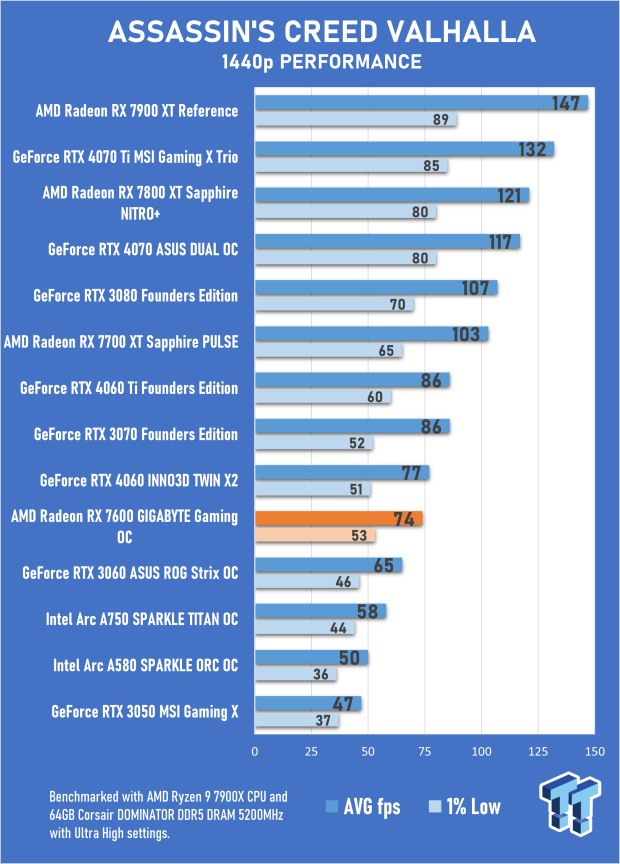
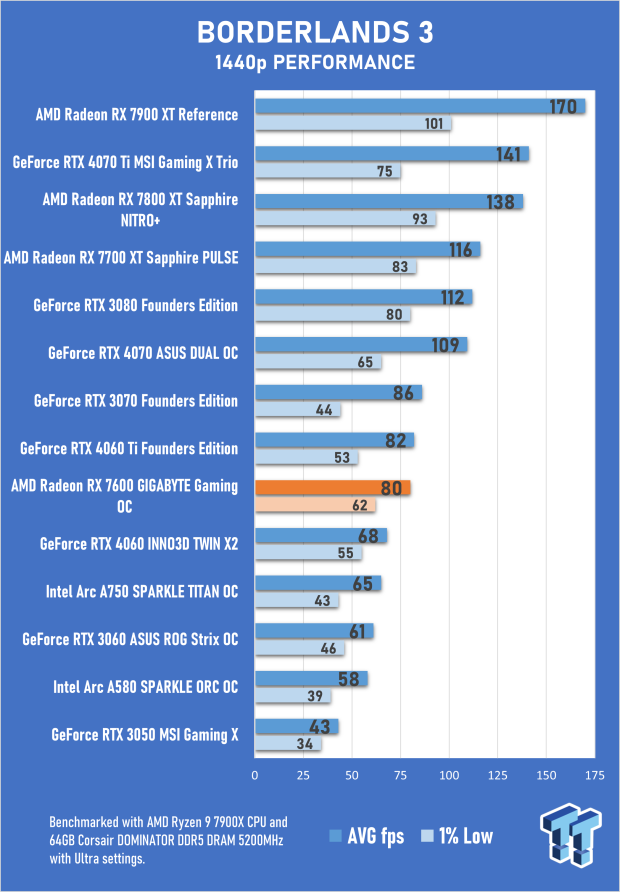
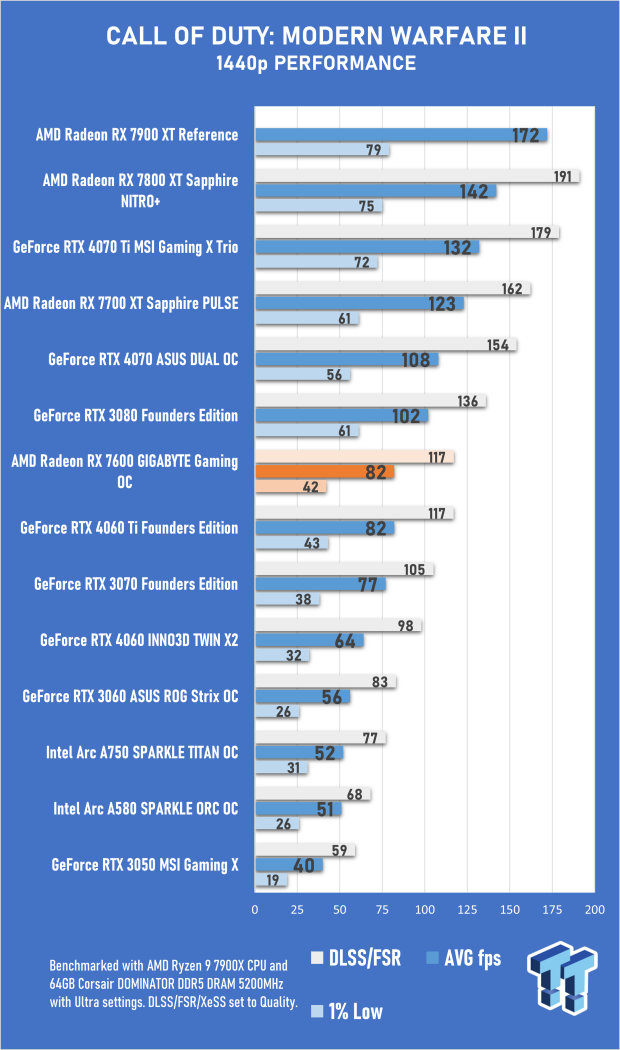
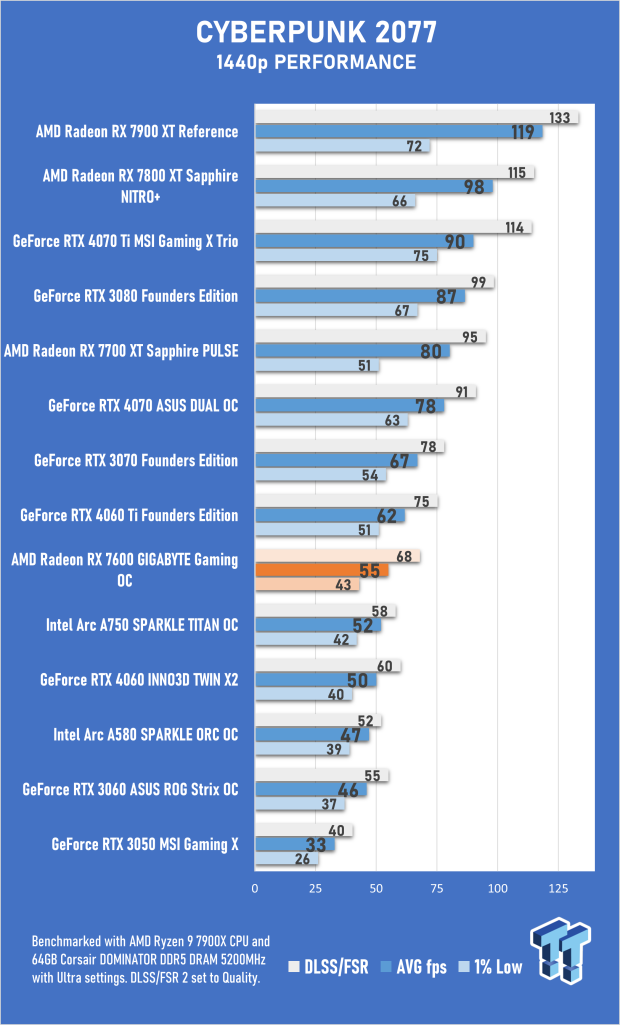
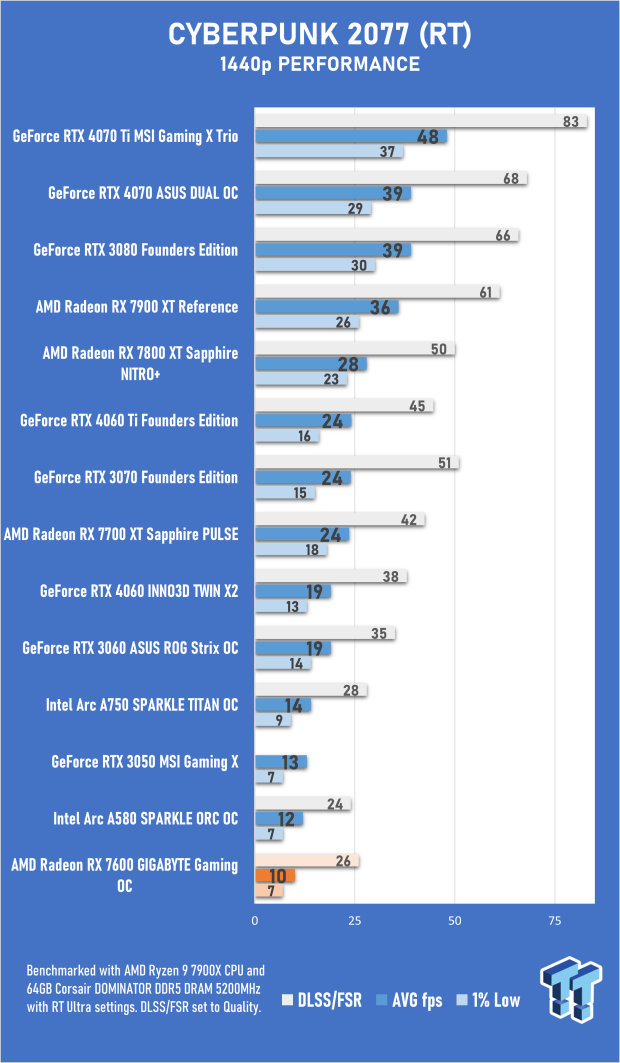
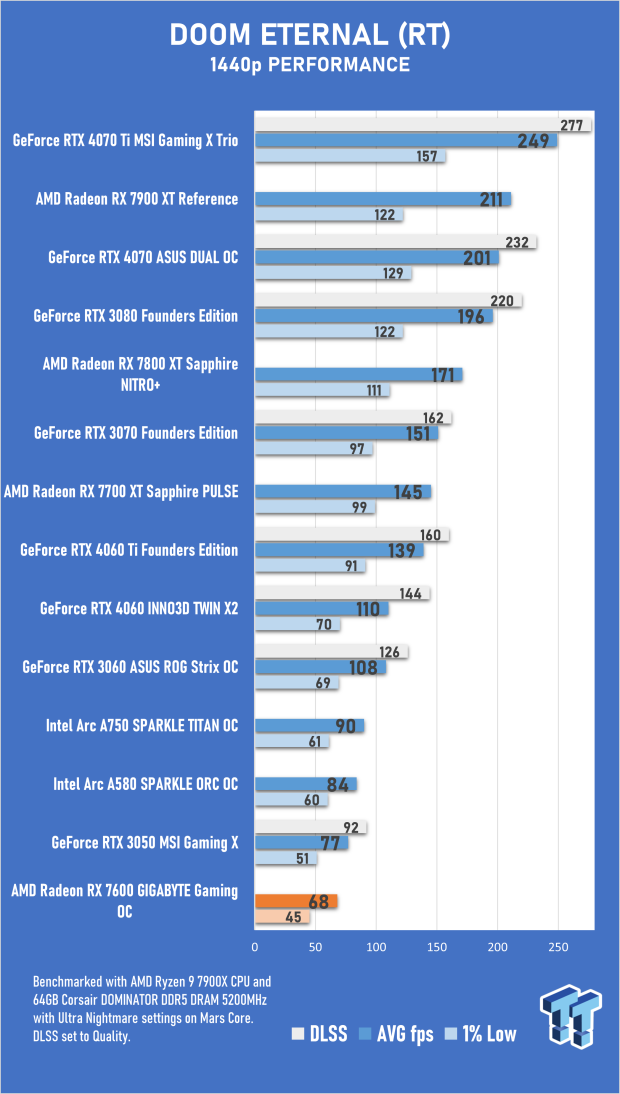
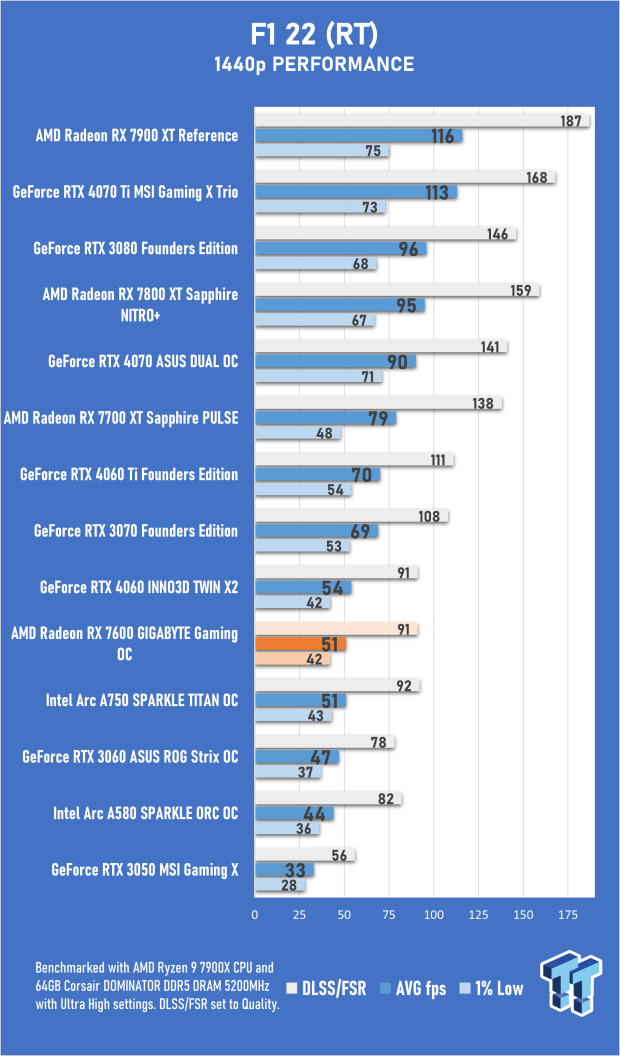
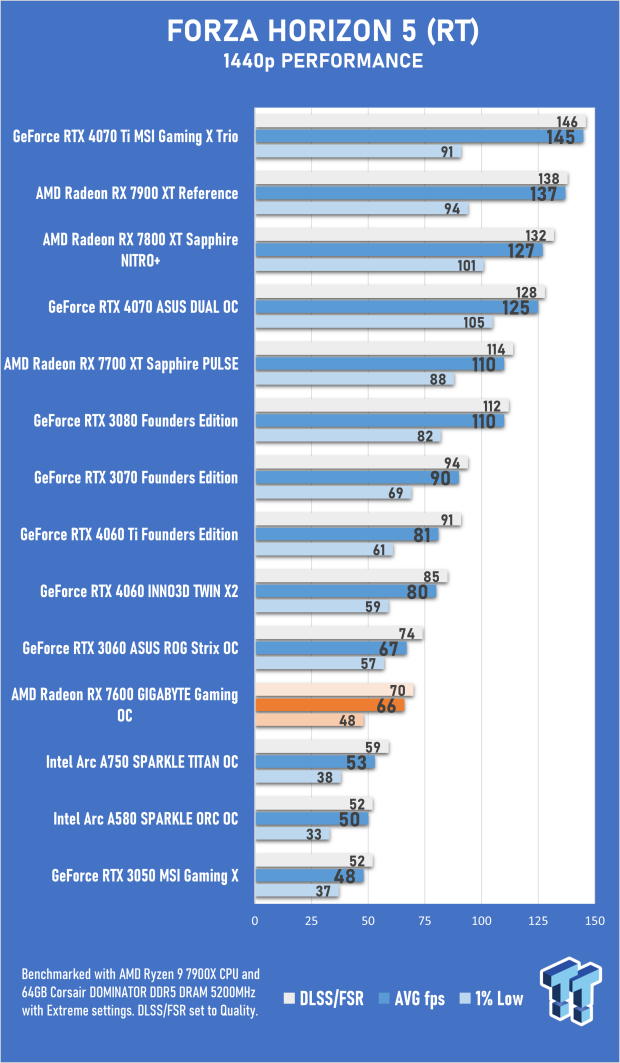
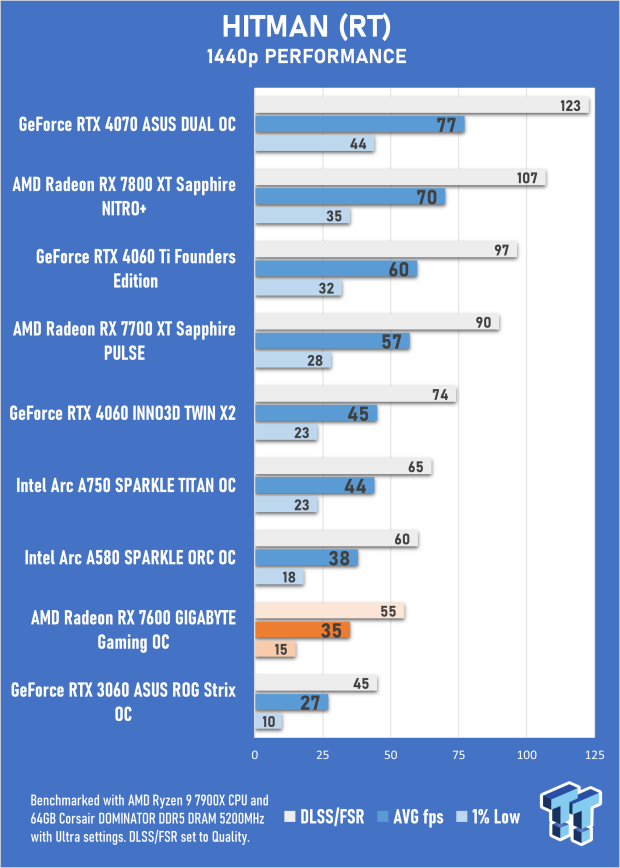
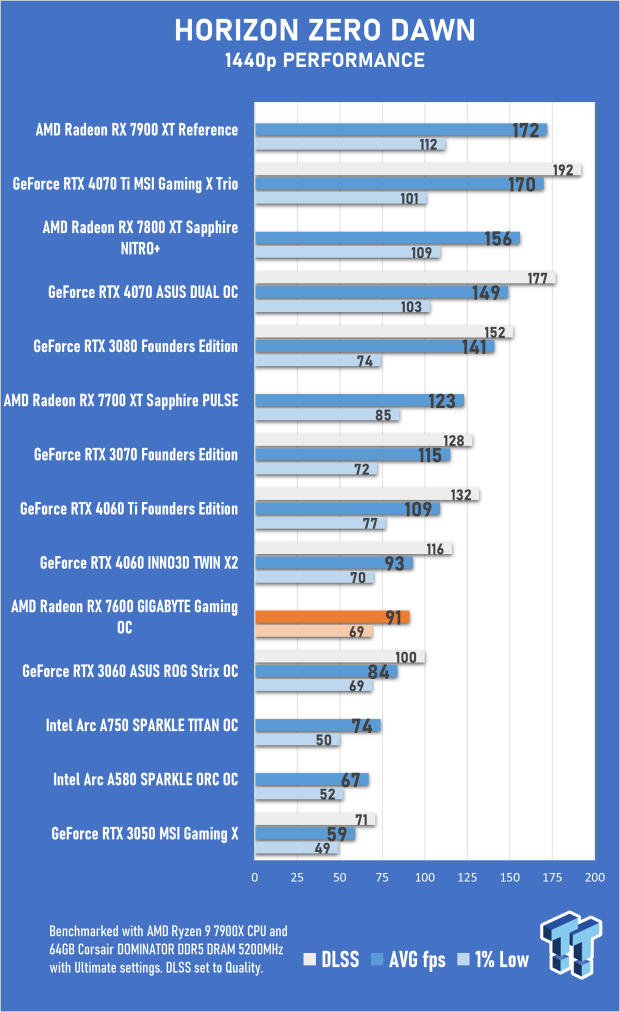
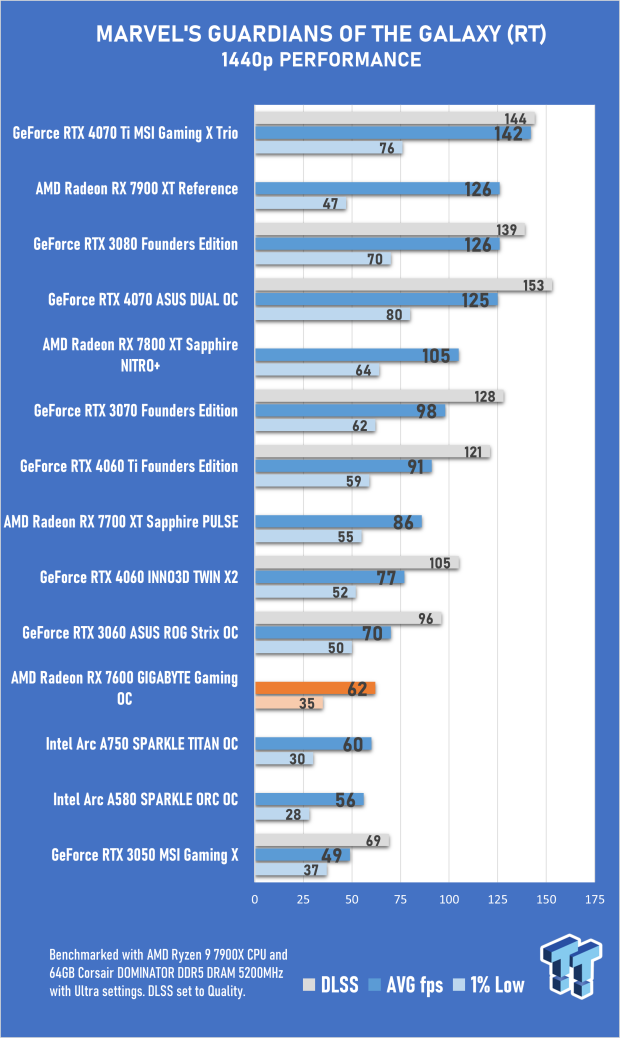
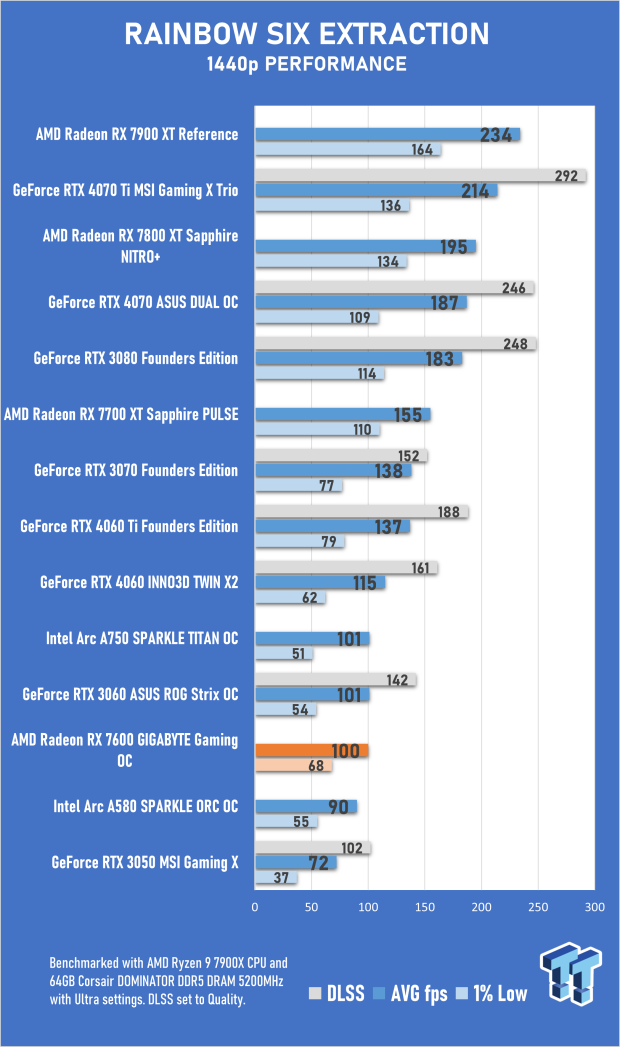
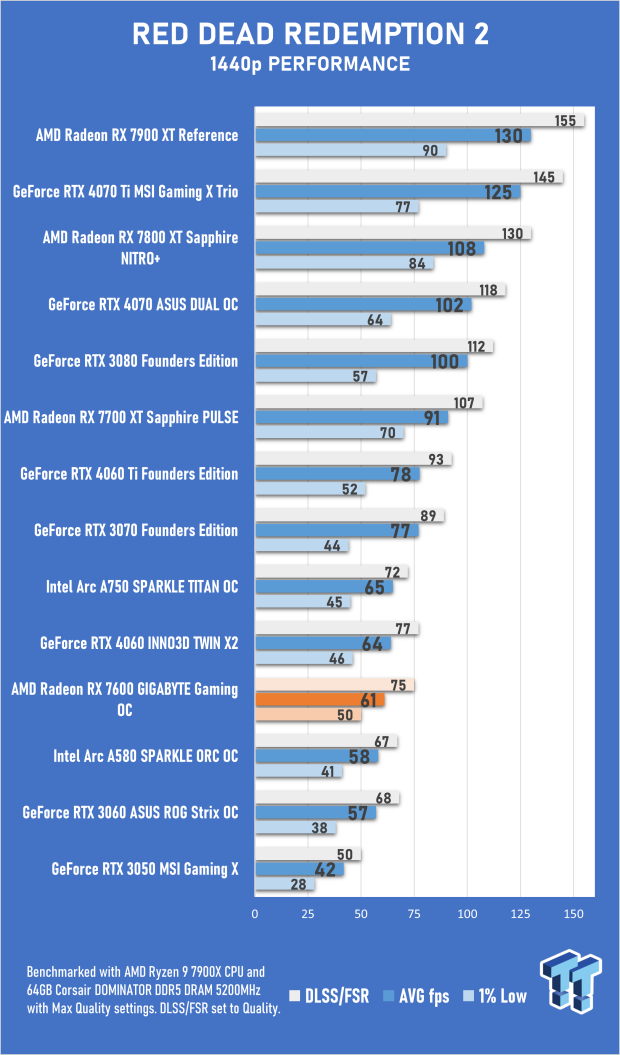
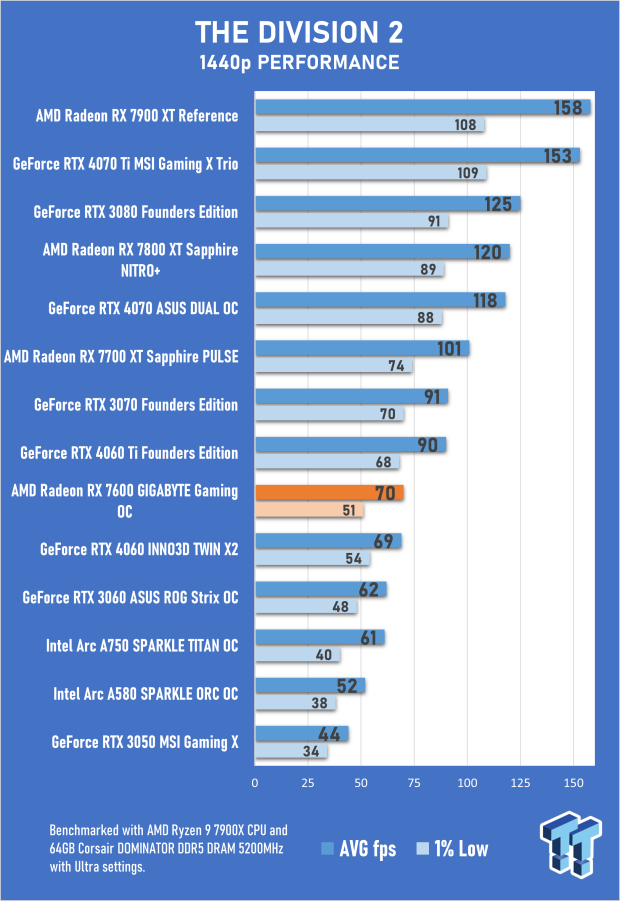
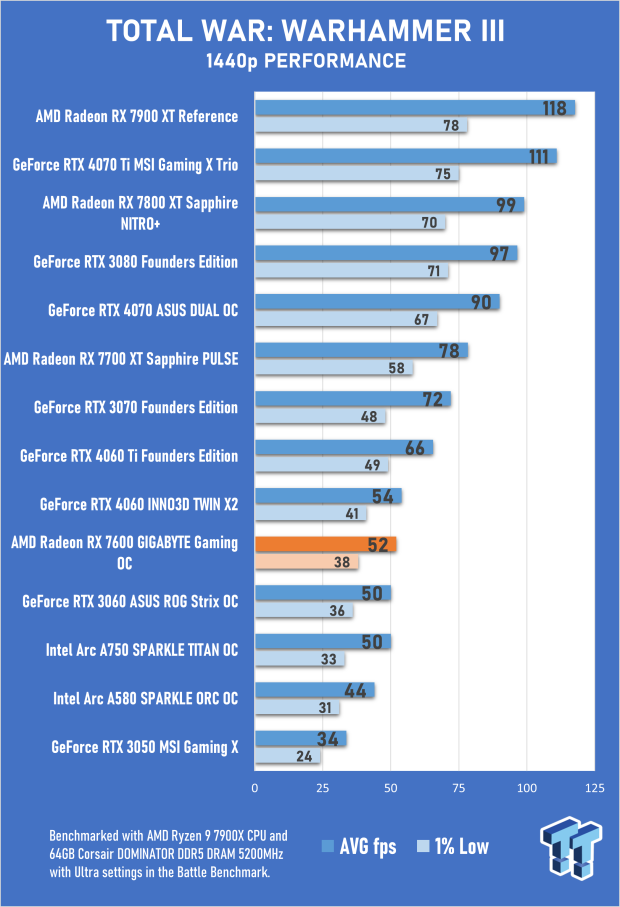
Benchmarks Summary, Ray-Tracing Performance, and FSR 3
AMD launched and continues to market the Radeon RX 7600 as a mainstream 1080p gaming GPU - and based on the results for the GIGABYTE Radeon RX 7600 OC 8G, we agree. Sure, it can deliver faster than 60 FPS performance in a few games here and there at 1440p with high-quality visual settings, but you get the best results when sticking to 1080p. The 8GB of VRAM feels more at home at this resolution as you run into bottlenecks and memory constraints in some games with 8GB of VRAM at 1440p.
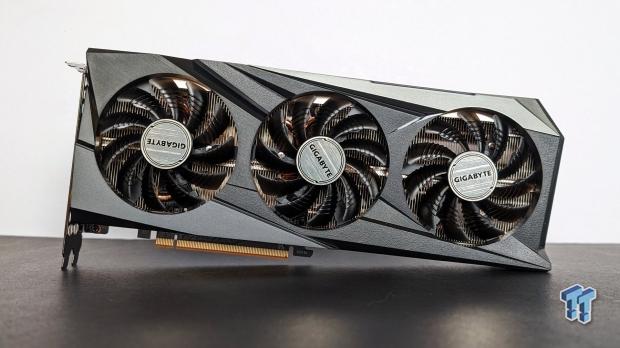
Ultimately, the performance sits between the GeForce RTX 3060 and the GeForce RTX 4060, with a lower price. The trade-off is that the overall power efficiency isn't quite there, alongside ray-tracing performance. But the good news is that in recent weeks, AMD has finally launched the first version of its DLSS 3-like Frame Generation tech as a part of FSR 3. The first two games supporting FSR 3 and AMD's Fluid Motion Frames tech are Immortals of Aveum and Forspoken.
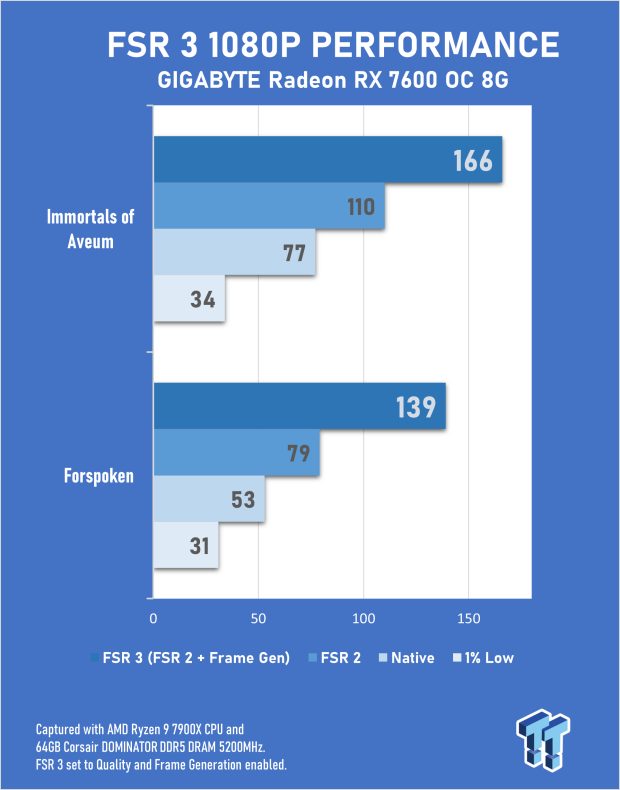
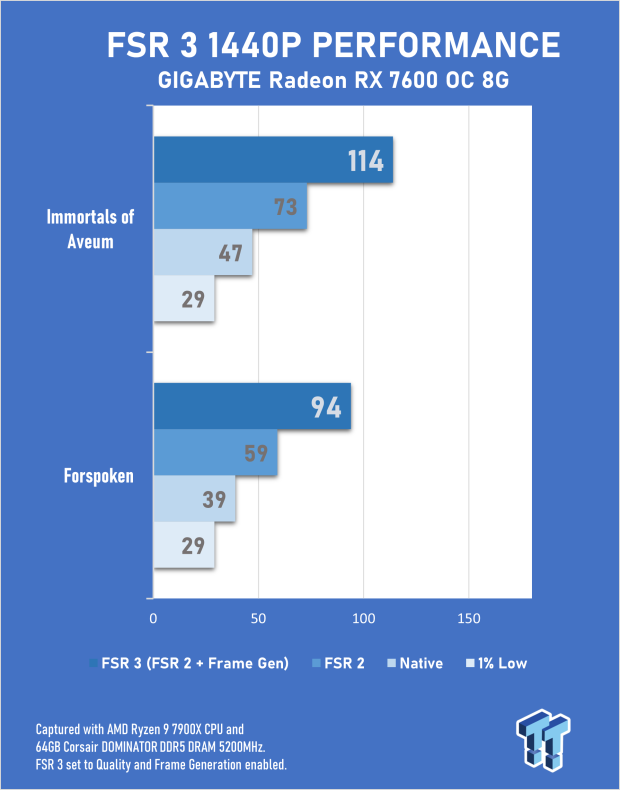
What surprised me about DLSS 3 Frame Generation, when enabled on the GeForce RTX 4060 and RTX 4060 Ti, was that the results were impressive at 1080p (and in some games, 1440p). This was surprising because to get the best out of DLSS 3 on the GeForce RTX 40 Series, you must enable DLSS 2 Super Resolution for upscaling, Frame Generation, and NVIDIA Reflex. With FSR 3 on the Radeon RX 7600 (excluding the higher-end Radeon RX 7000 Series GPUs), the results are impressive in terms of numbers but disappointing regarding visual fidelity and overall stability.
There's room for improvement, and in Forspoken, the game felt good enough to play with FSR 3 at 1080p - but you do lose out on image quality compared to DLSS.
Temperature and Power Efficiency
In our stress test under full load, the GIGABYTE Radeon RX 7600 OC 8G drew about 180W of power, higher than expected for a mainstream GPU offering from AMD. The company's RDNA 3 architecture doesn't seem as impressive as RDNA 2, or when stacked up to the 110W or so of the GeForce RTX 4060. It's a shame, but the good news is that the Radeon RX 7600 still falls within the 1 x 8-pin power connector range, so it's compatible with most rigs.
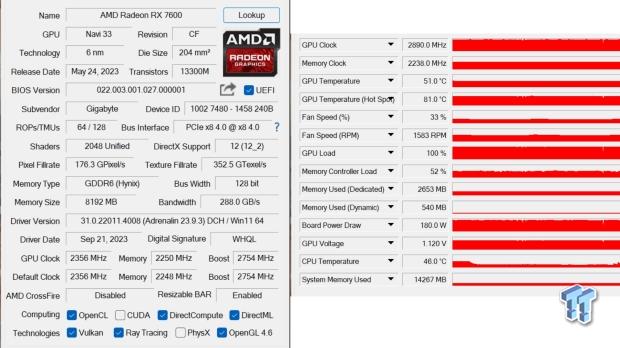
The cooling performance of the GIGABYTE Radeon RX 7600 OC 8G is excellent, with the GPU temperature staying well below 60 degrees and fan speeds kept to a modest 30% capacity or roughly 1500 RPM. Compared to AMD's reference design, which does feature a stylish all-metal build, the difference is night and day. And it's quiet to boot.
Final Thoughts
The sub-USD 300 market for GPUs comprises second-hand cards, older models being sold at a discount, and a handful of brand-new GPU options like the GIGABYTE Radeon RX 7600 OC 8G. For two out of three, the question of value depends on local availability, but when strictly looking at brand-new GPUs, the main competition for the Radeon RX 7600 is still the GeForce RTX 3060 and the GeForce RTX 4060. The RTX 3060 might be showing its age, but it's still very popular and readily available in most locations.
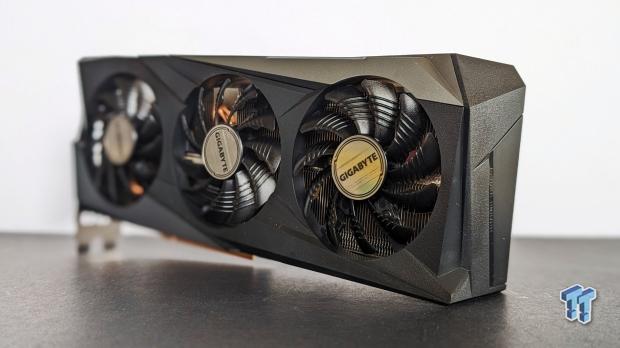
The GIGABYTE Radeon RX 7600 OC 8G delivers a notable performance increase over the GeForce RTX 3060 in most games, except those with heavy ray-tracing workloads. Compared to the GeForce RTX 4060, it's mostly on par but falls short in a few areas - again, ray-tracing being one area. Ultimately, high-end RT is not what most people look for in a mainstream GPU, and the 1080p performance here is solid. It is backed up by excellent cooling and thermal performance in the low-profile compact GIGABYTE Radeon RX 7600 OC 8G.


